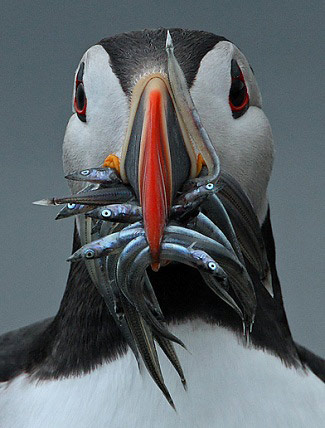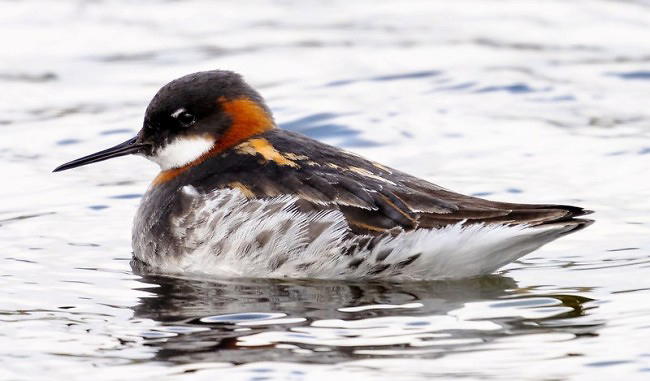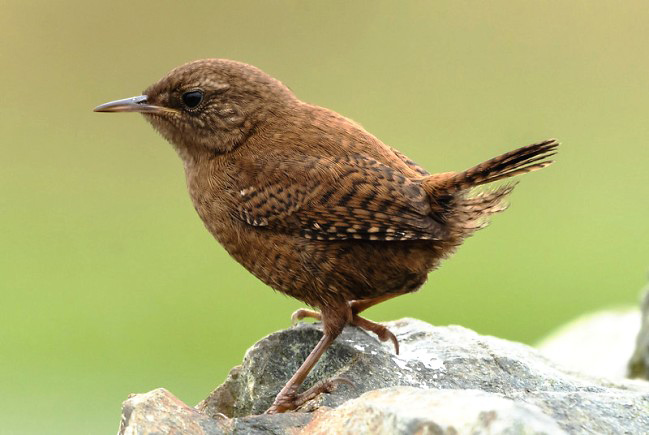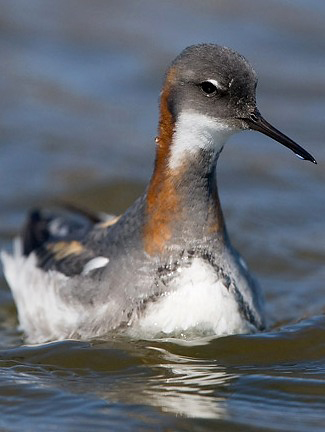

Atlantic Puffin with sandeels, taken by Steve Garvie.
- Some of the world's most spectacular seabird cliffs with colonies of Puffins, Black and Common Guillemots, Razorbills, Kittiwakes, Fulmars and Gannets
- Some with Puffins a few feet away
- The best place in Britain for nesting Red-necked Phalaropes
- A fine selection of other nesting shorebirds
- And other spectacular birds such as Great Skua
- As well as a good chance of Otters
- And a chance of Killer Whales
- About 800 miles north of London, as the Puffin flies, at the most northerly point of the British Isles, there is a different kind of city, called Hermaness. A metropolis in fact, where over 100,000 seabirds live, including Gannets, Guillemots, Kittiwakes, Razorbills, Shags and Fulmars. The fishy stench of guano, the din, the packed ranks of birds on the ledges of the almost vertical 170 metre high cliffs, the swirling clouds of birds and the rafts of yet more birds bobbing on the wild sea below is one of the greatest scenes in the natural world, completed on the cliff-tops by about 25,000 pairs of Puffins! The Puffin is one of the most recognizable birds, thanks mainly to its penguin-like upright stance and amazing multicoloured beak. Having spent the winter at sea, pairs usually return to the same underground burrow they raised their youngster in the year before. The females lay a single egg which is incubated for five to six weeks then both parents feed the youngster, called a puffling, usually with beakfuls of sandeels, for about six weeks. Then the baby Puffin is left to find its own way to the sea, which normally involves flinging itself off the cliff-top at night and (sort of) flying for the first time, usually straight down ... to the sea, usually and remarkably without harm! One of the best places in the world to see Puffins is Hermaness, about 80 miles plus two short ferry rides north of Sumburgh at the northern tip of Shetland. The only problem is the hour long walk from the visitor centre to the cliffs. About 750 pairs of Great Skuas, or Bonxies as they are known in Shetland, nest on the moorland, the third largest concentration in the world, and Bonxies will dive-bomb any visitors who stray too close to their young. Braving the Bonxies is more than worth it though, for Puffins are totally different. They are completely at ease in the company of humans and it’s possible to watch them from arm’s length!
- Shetland is closer to Bergen in Norway than Aberdeen in Scotland and during the height of summer it is possible to look for birds and other wildlife almost 24 hours a day in what is locally known as the ‘Simmer Dim’, birds such as the Tammie Norie (Puffin), Bonxie (Great Skua), Maalie (Fulmar), Scarf (Shag), Solan Goose (Gannet) and Tystie (Black Guillemot) as they are known in Shetland.
- Fair Isle lies south of Shetland, almost exactly half way to Orkney. It is accessible by air and sea from Shetland. This is an island of high sea cliffs with seabird colonies and its own fridariensis subspecies of Wren but is arguably more famous for the numerous rare birds which have turned up. Seabirds include Arctic and Great Skuas, and Black Guillemot.
- The Orkney islands lie just 16 km (10 miles) north of the coast of Caithness, mainland Scotland. Breeding and summering species include all three divers (loons), Hen Harrier, Merlin, Short-eared Owl, Puffin (at Noup Head, Westray for example), Black Guillemot and Bonxie (over 1900 pairs on Hoy alone) and the islands are famous for rare birds, notably North Ronaldsay where there is a bird observatory. There is also a chance of Otter and the Scottish Primrose which is endemic to Orkney and a few sites along the north coast of Scotland, and usually begins flowering in early May.
- For information on the rest of Scotland see the Scottish Highlands where it is possible to see Pine Marten, Bottlenose Dolphin (in the Moray Firth, especially from Chanonry Point or bow-riding boats out of Cromarty), Red Squirrel, and several localized birds in Britain including Golden Eagle, (Western) Capercaillie, Black Grouse, Red Grouse, (Rock) Ptarmigan, Osprey, Slavonian (Horned) Grebe, (Eurasian) Dotterel (May-Aug) and Crested Tit (usually easiest to see well during the northern winter when the species visits feeders, for example at Loch Garten, Boat of Garten and Loch an Eilean). Also, Mull is a great place for White-tailed Eagles, which can also be seen along with Corn Crakes on the Outer Hebrides.

Red-necked Phalarope on the island of Fetlar, Shetland, by Paul Macklam.
Best Birds and other wildlife in Shetland
Birds
The species listed here are usually present during the northern summer.
Specialities
European Storm-petrel, Red-necked Phalarope (third week of May to late July), Great Skua, Arctic Skua, (Atlantic) Puffin, Black Guillemot and ‘real’
Rock Dove. Also a chance of King Eider and Spotted Crake.
Others
Whooper Swan, Common Eider, Red (Willow) Grouse, Red-throated Diver (Loon), (Northern) Fulmar, (Northern) Gannet, (European) Shag,
(European) Golden Plover, (Northern) Lapwing, Black-tailed Godwit (islandica subspecies), (Eurasian) Curlew, Whimbrel, (Common) Snipe, Redshank,
Dunlin, (Black-legged) Kittiwake, Arctic Tern, Common Guillemot (Murre), Razorbill, Hooded Crow, (Winter) Wren (zetlandicus subspecies), (Northern)
Wheatear, Rock Pipit and Twite. Also a chance of Long-tailed Duck, Great Northern Diver (Common Loon), Black-throated Diver (Loon), Manx Shearwater,
Hen Harrier and Short-eared Owl.
Rarities
Rare birds turn up regularly during the spring (usually to mid-June at least) and have included Black-browed Albatross (at Hermaness every
summer 1972-1995 except 1988-89), Caspian Plover, Pallas’s Sandgrouse, White-throated Needletail, Ruppell’s Warbler and Common Yellowthroat. It is
not surprising then that the Shetland list of birds is over 430. For all the latest news on birds and mammals, including Killer Whales, see
Nature in Shetland.
Mammals
(Eurasian) Otter, Harbour Porpoise, Common and Grey Seals, and Arctic Hare. Also a chance of Humpback, Killer and Minke Whales, and Risso’s, White-beaked
and White-sided Dolphins.
Plants
The flora includes Bog Bilberry, Crowberry, Butterwort, Lousewort, Moonwort, Early Purple, Frog and
Northern Marsh Orchids, Oysterplant, Stone Bramble, Sundew and the endemic Shetland (Edmonston’s) Mouse-Ear Chickweed. Arctic-alpines include
Arctic (Norwegian) Sandwort, Moss Campion and Northern Rock Cress.

The strongly barred and rufous Shetland race of Wren on the island of Fetlar by Paul Macklam.
Best Sites for Birds and other wildlife in Shetland
- Sumburgh Head, Mainland High sea cliffs with seabird colonies, complete with close-up Puffins, Guillemots, Razorbills, Kittiwakes, Fulmars and Shags. Also Twite, a chance of cetaceans offshore, and rarities at the head, Sumburgh Farm, the Sumburgh Hotel grounds and Grutness (33 species of warbler have been recorded in this area and six species of American passerine), as well as the nearby Pool of Virkie and Loch of Hillwell.
- Scatness, Mainland Arctic Tern, and Common and Grey Seals.
- Tingwall, Mainland Red-throated Diver, Red-breasted Merganser, Britain's only breeding Whooper Swans and Arctic Hare.
- Eshaness/Urafirth Oysterplant. Superb cliffs, natural arches, geos and blow holes. Also, a chance of cetaceans.
- Mousa This island supports the UK’s largest population of European Storm-petrels (about 11,800 pairs), viewable on organized late-evening/night boat trips around the 13 m (43 ft) high 2000-year-old Iron Age broch (from mid-May to late July). Also, during the day, very approachable Arctic Terns, Arctic and Great Skuas, and Black Guillemots, as well as Red-throated Divers.
- Noss A National Nature Reserve with spectacular sea cliffs rising to 180 m (591 ft), believed by some to be the best bird cliffs in Britain, with about 160,000 pairs of nesting seabirds, including 40,000 Guillemots, 20,000 Gannets and 5000 Kittiwakes, as well as Puffins, Black Guillemots, Razorbills and Fulmars. Also present on the island are about 400 pairs of Great Skua, and Arctic Tern, and rare birds recorded on the island include Lesser Kestrel and Hermit Thrush, both in 2017. Boat tours from Lerwick circumnavigate the island allowing views looking up to the Gannet colony, as well as Guillemots, Razorbills and Kittiwakes, or it is possible to be picked up by small boat from the adjacent island of Bressay and land on Noss and climb the Noup to look down on the birds and sit with the Puffins at the cliff-edge.
- Foula Spectacular sea cliffs rising to 369 m (1210 ft) and one of the largest 'colonies' of Great Skua in the world.
- Yell The highest density of Otters in Shetland.
- Keen of Hamar A National Nature Reserve with a rich flora on serpentine rock debris which includes the Arctic-Alpines Arctic (Norwegian) Sandwort, Moss Campion and Northern Rock Cress, as well as the endemic Shetland (Edmonston’s) Mouse-Ear Chickweed which grows no where else in the world and is usually at its best from mid-May to early July.
- Hermaness, Unst A National Nature Reserve with spectacular sea cliffs, rising to 170 m (560 ft) at the Neap, with over 100,000 seabirds including about 50,000 Puffins, 40,000 Guillemots, 28,000 Fulmars and 20,000 Gannets, as well as, on the moors inland, the second largest 'colony' of Great Skuas in the world (about 800 pairs) – be prepared to be bombarded by Bonxies (the local name for Great Skuas), which are rather aggressive in defence of their young! The flora includes Bog Bilberry, Butterwort, Crowberry and Sundew. Muckle Flugga Lighthouse is also visible from here.
- Fetlar One of two (and the largest and most reliable) regular Red-necked Phalarope colonies in the British Isles (at Mires of Funzie from the third week of May to late July). Also, Red-throated Diver, Golden Plover, Whimbrel, Dunlin, Arctic Tern, and Arctic and Great Skuas, as well as a good chance of Otter and several species of orchid.

A delightful Red-necked Phalarope by Michael McKee.
Best Times for Birds and other wildlife in Shetland
Mid-May to late June is the best time to be in Shetland for birds, late May to the end of July for Red-necked Phalaropes. Puffins are usually present from mid-April to early August but the young usually hatch in June so the parents visit the nesting burrows more often. Average temperatures in June range from 7°C to 13°C so it’s not very warm and the weather can change quickly so warm, windproof and waterproof clothing is recommended.
The cliffs at Hermaness and at other places in Shetland are very dangerous. Be careful not to go too near the edge, especially when the mist or rain rolls in. It can also be wet and windy but wearing waterproof trousers is not recommended near the edges of these cliffs because it is much easier to slide over the edge of them with such gear on. Also, watch out for the Bonxies on the walk from the visitor centre to the cliffs at Hermaness. These birds may fly fast and close at visitors who enter their territories but rarely make contact. For peace of mind visitors may wish to carry a stick or wave their arms to keep the birds at bay.
Recommended Bird Books etc. for Shetland
Collins Bird Guide by L Svensson et al. Collins, 2010 (Second Edition).
RSPB Handbook of Scottish Birds by P Holden and S Housden. Bloomsbury, 2018 (Second Edition).
Birds of Europe by L Jonsson. Helm, 1999.
Where to Watch Birds in Scotland by M Madders and J Welstead. Helm, 2002 (Fourth Edition).
The Birds of Shetland by M Pennington et al. Helm, 2004.
A Naturalist’s Shetland by J Laughton Johnston. Poyser, 1998.
Mammals of Europe, North Africa and the Middle East by S Aulagnier et al. Helm, 2009.
The Butterflies of Britain and Ireland by J Thomas and R Lewington. British Wildlife Publications, 2014 (Third Edition).
Wild Flowers of Britain and Ireland by M Blamey, R Fitter and A Fitter. Bloomsbury, 2013 (Second Edition).
Apps etc.
Collins Bird Guide.
RSPB eGuide to British Birds.
iBird UK & Ireland Guide to Birds.
Birds of Britain and Ireland.
Bird Id - British Birds.
Birder - Guide to Birds of Britain and Ireland.
Where to watch birds in Europe & Russia by N Wheatley. Helm, 2000.
Don’t know which country/countries/regions to visit in Europe? Then it may be worth considering taking a look at this book, written by this website’s author. It is many years old of course but it still provides a starting point, an overview and a guiding light to the best birds and the best places to look for them in the region, and could save hours of searching for similar information on the internet. However, it is important to check more up-to-date sources for sites which have been opened up, sites and species which have been discovered, lodges that have been built etc. since the book was published.
Birding and Wildlife Trip Reports for Shetland
Many trip reports, some for Shetland, are posted on the websites listed here. On some of these websites some reports are independent and some are posted by tour companies who organize tours to Shetland. These tour companies and others also post their own reports on their websites, which are listed under 'Some Organized Tours to Shetland' below.
- The best website for trip reports is CloudBirders
- but these are also worth a look
- Birdtours
- Fatbirder
- Jon Hornbuckle
- Mammal Watching
Local bird and wildlife guides in Shetland
The costs of organized tours partly reflect the quality of the tour leaders. Some leaders are certainly better than others and many companies claim their leaders are the best but even the best rely at least to some extent on the exceptional skills of the local guides they employ. If you are travelling independently, employing such local guides will greatly increase your chances of seeing the wildlife you wish to see.
Accommodation for birders in Shetland
Some Organized Tours for birds and other wildlife to Shetland
There are many tour companies who organize tours to see mammals, birds, other wildlife and other natural wonders. The cost of these tours vary considerably according to such variables as the airlines used, the number of days the tours last, the number of sites visited, the number of people in the group (an important consideration if you wish to see such wildlife as rainforest mammals and birds), the number of tour leaders, the standard of accommodation and transport, and the percentage profit the company hopes to make. Generally, where the number of days tours last and the number of sites visited are similar, the cheapest tours are those that use the cheapest airlines, accommodation and local transport, that have the largest groups with the least number of leaders, and that make the least amount of profit. The most expensive tours tend to be those which are exceptionally long, use the most expensive accommodation (ridiculously lavish in some cases, even for single nights) and which make the most profit. Some tour costs partly reflect the quality of the tour leaders. Some leaders are certainly better than others and many companies claim their leaders are the best but even the best rely at least to some extent on the exceptional skills of the local guides they employ.
While tour companies organize tours with set itineraries many also organize custom tours for individuals and private groups who instead of taking a tour with a set itinerary want to follow their own itinerary to suit their own personal tastes, whether it be mammals, birds, other wildlife, other natural wonders or even man-made attractions, or a mixture of them all. Many organized tours with set itineraries are also fast-paced and target as many species as possible, whether they are mammals, birds or other wildlife or everything, which usually leaves little time to enjoy the best sites and individual species, but on a custom tour those taking part can specify the pace and the sites and species they wish to concentrate on. Custom tours also suit people who like to travel with people they already know, rather than with a group of strangers, and they are popular with people with partners with different interests. Individuals, partners and small groups will almost certainly have to pay more for a custom tour than an organized tour with a set itinerary but a large group of friends may be able to travel for less than the price quoted for a set tour.
Tour companies who run organized tours to Shetland include the following. Many of these also offer custom tours.
